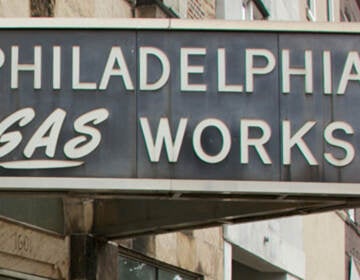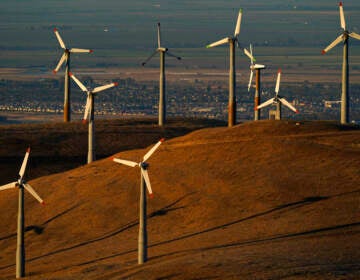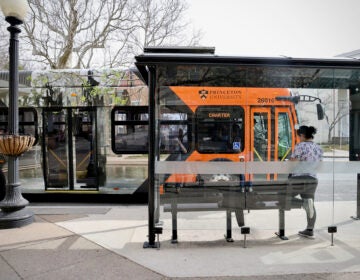Green hydrogen: A climate change solution or fossil fuel bait and switch?
To help solve the climate crisis, $750 million could flow to the Philadelphia region to create a hydrogen economy. But some say it’s a deceit to help the fossil fuel industry.
Listen 7:34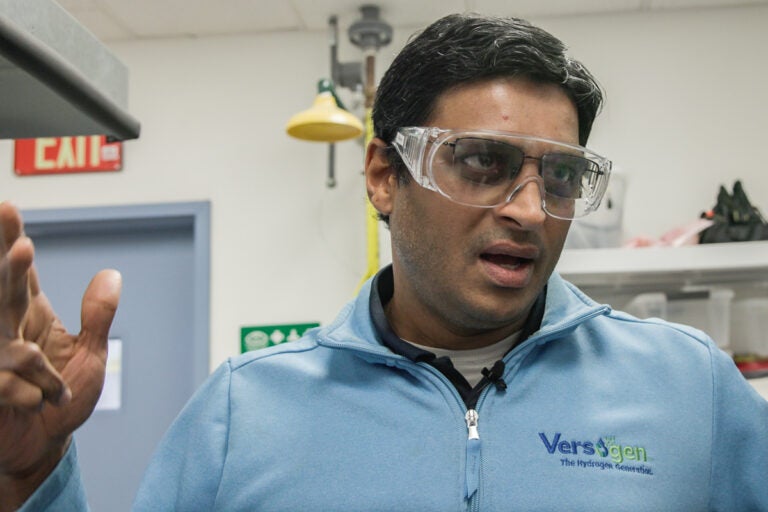
Balsu Lakshmanan, CTO of Versogen, inside his research lab where researchers are testing an electrolyzer that could make hydrogen production more sustainable and affordable. (Kimberly Paynter/WHYY)
This story is part of the WHYY News Climate Desk, bringing you news and solutions for our changing region.
From the Poconos to the Jersey Shore to the mouth of the Delaware Bay, what do you want to know about climate change? What would you like us to cover? Get in touch.
On the campus of a former DuPont facility in Newark, Delaware, a group of researchers are working to create what they say is key to solving the world’s climate crisis — an affordable way to make hydrogen using renewable energy.
“It’s not a question of technical feasibility. It is a question of figuring out what is the lowest cost to produce that hydrogen,” said Balsu Lakshmanan, chief technology officer for the start-up Versogen. “We are displacing bad hydrogen with good hydrogen.”
The world is full of what he referred to as “bad hydrogen.” Nearly all the hydrogen used today is made with natural gas, in a process known as “steam methane reformation,” or through coal using gasification. And while hydrogen burns clean when used in fuel cell cars, trucks and buses — emitting only water vapor — climate warming gasses like carbon dioxide are released during hydrogen production.
Ten million metric tons of hydrogen are produced in the U.S. every year. More than 1,600 miles of pipeline transports it — primarily in the Gulf Coast.
The bulk of the hydrogen is not used to power vehicles but as part of oil refining, including those in the Philadelphia region. It’s also used to help feed us all — it’s used to make ammonia, a key ingredient in fertilizer.
The process to make hydrogen using renewables is simple enough. A machine called an electrolyzer zaps water with electricity, splitting the water molecules into their elements, oxygen and hydrogen. Versogen’s electrolyzer would be the size of a tractor trailer, and could be placed by a solar array or offshore wind farm, according to Lakshmanan.
Electrolyzers aren’t new: The first electrolyzers generated hydrogen more than 200 years ago.
But they’re not cheap, said Yushan Yan, founder and CEO of Versogen and the Henry Belin du Pont Chair of chemical and biomolecular engineering at the University of Delaware.
Right now, it’s five times more expensive to make clean hydrogen than it is to make dirty hydrogen using coal or natural gas. Of course, that does not factor in any of the environmental or health costs associated with burning fossil fuels.
“Natural gas came along, and the production of hydrogen was so much cheaper,” said Yan. “So we went for that, and we tolerated the emissions associated with natural gas. And you would say, ‘Why didn’t we use electrolyzers?’ Because at the time they were very expensive, and they are still very expensive today. So that’s the problem we are trying to solve.”
The Department of Energy has a goal to get the direct cost of green hydrogen down to $1 per kilogram of hydrogen by 2031, compared to $4.5 to $12 per kilogram today.
Enter the MACH2 hydrogen hub
In order to close that gap and jump start hydrogen production, the Biden administration will invest $7 billion in seven “hydrogen hubs” across the country, including one in the Philadelphia region. In October, President Joe Biden announced the plan at the Tioga Marine Terminal, saying a hydrogen economy would create thousands of new jobs and cut climate-warming carbon dioxide.
“Those hubs are about people coming together across state lines, across industries, across political parties to build a stronger, more sustainable economy and to rebuild our communities,” Biden said.
Energy Secretary Jennifer Granholm described the hubs as the “dawn of a new manufacturing sector in the United States.”
It’s part of the administration’s goal to achieve net zero carbon emissions by 2050 — meaning the amount of carbon dioxide going into the atmosphere is balanced by removing carbon emissions over a period of time. This requires replacing coal and oil with cleaner fuels. The funding comes from the 2021 Bipartisan Infrastructure Law. The administration claims most projects would fast-track commercial scale “clean hydrogen” production.
Projects in Pennsylvania, Delaware and New Jersey would collectively make up what is known as the Mid-Atlantic Clean Hydrogen Hub, or MACH2, which would get $750 million to help utilize the region’s legacy fossil fuel infrastructure, including pipelines, oil refineries and port facilities. The bulk of the current MACH2 proposals would use renewable energy, along with nuclear power, to make hydrogen.
As part of that proposal, Versogen would get more than $34 million to help develop its new electrolyzer, which is estimated to cost about $224 million.
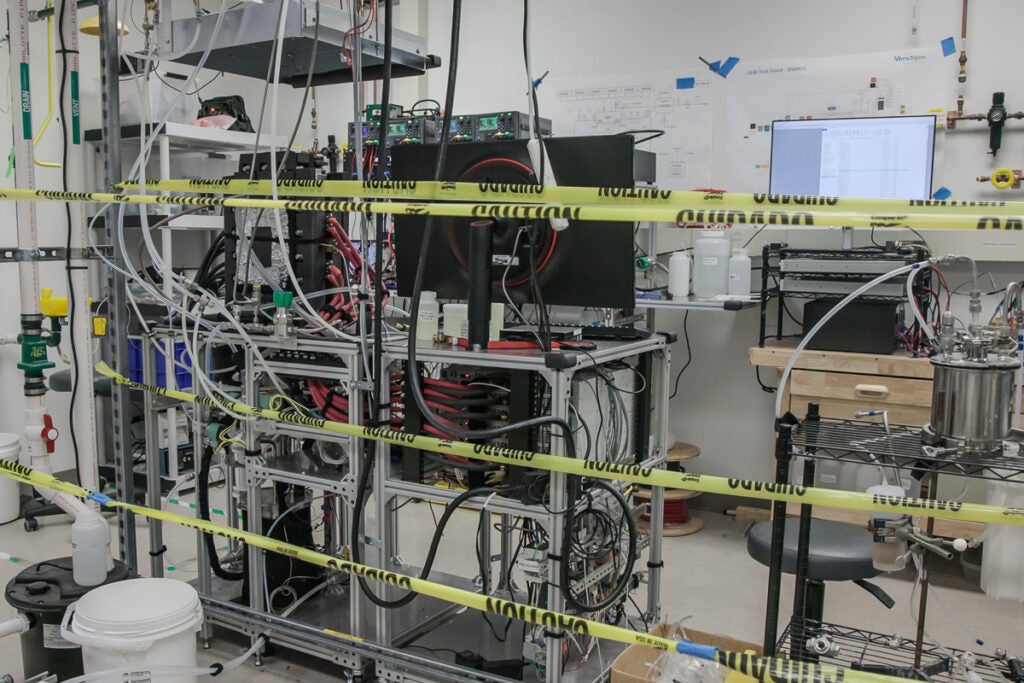
Another example of a MACH2 project includes building a solar field at the PBF refinery in Delaware City, which would provide the electricity to make hydrogen using an electrolyzer instead of the currently used steam methane reformation. SEPTA is planning a pilot project to run hydrogen fuel cell buses and Philadelphia Gas Works, the nation’s largest municipal-owned utility, would use hydrogen to power trucks at the Port of Philadelphia.
The region also already has miles of pipelines that connect the different refineries in Delaware and New Jersey, which MACH2 officials say can be re-sleeved to carry hydrogen instead of oil or natural gas. MACH2 officials also promise to create 20,000 jobs. Project labor agreements are part of the plan, ensuring a union workforce.
At the first public meeting about MACH2 at the Steamfitters Local 420 union hall in Northeast Philadelphia, Pennsylvania Governor Josh Shapiro called the hydrogen hub a “big deal.”
“Because today is the beginning of engagement on building a clean energy future here in the Commonwealth of Pennsylvania,” said Shapiro, which drew applause from the crowd of more than 100 union members and fossil fuel executives, but heckling from opponents.
“We are all in when it comes to the hydrogen hubs here in the Commonwealth of Pennsylvania,” Shapiro said. The state is also part of the DOE approved ARCH2, or Appalachian Regional Clean Hydrogen Hub.
The chairman of MACH2, Collin O’Mara, pitched the plan as a win-win to the crowd at the union hall: make use of the area’s oil refining infrastructure, cut carbon emissions and create good jobs, while at the same time — which O’Mara stressed is key — avoid creating even more pollution.
“We can have both zero emission technologies, and we can have a ton of union jobs making things and show that Philadelphia not just powered the last century, but will power the next century as well,” said O’Mara to cheers.
O’Mara currently leads the National Wildlife Federation and is running for governor of Delaware. He served as the head of Delaware’s Department of Natural Resources and Environmental Control from 2009 to 2014.
The White House says the impact of the regional hydrogen hubs includes eliminating 25 million metric tons of carbon dioxide, which equates to more than 5.5 million gas powered cars each year. It also says the combined public and private investments will reach $50 billion.
Climate savior or boondoggle?
But critics say the hydrogen hubs are the greatest boondoggle since the Concorde. Or worse, a bait and switch — promise green but deliver the same old dirty hydrogen once all the money flows in and the new infrastructure is built.
One person waving the red flag is Joseph Romm. Romm is a physicist and a senior research fellow at the University of Pennsylvania’s Center for Science, Sustainability and the Media.
“Let’s step back from the fairy-tale world where just because I can imagine it and make a PowerPoint presentation, that it’s going to magically come true and go into the real world where you actually have to compete,” said Romm.
In the 1990s, Romm worked at the Department of Energy where his specialty was efficiency of renewables, and that’s where he first began looking at hydrogen as an option to replace fossil fuels.
“You’ve got to become a commercial product and you’ve got to be safe and reliable and be able to demonstrate you have long-term viability so you can get low-cost financing,” he said. “Hydrogen’s got none of that.”
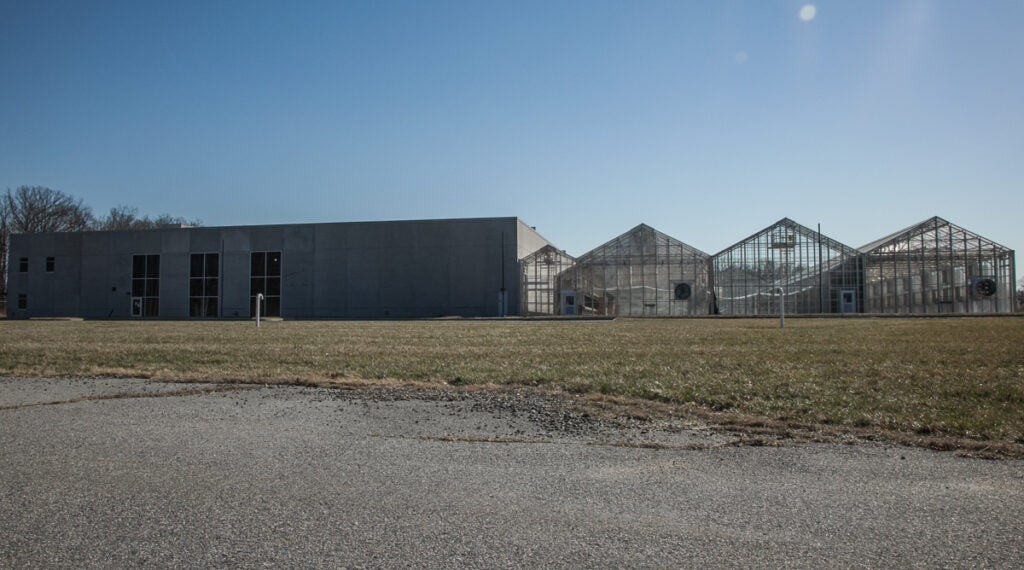
Romm says, first of all, there’s the safety issue.
“Hydrogen is a pain in the ass to work with,” he said. It’s prone to leak and ruin metals, it’s also highly explosive.
And when it comes to long-haul trucking or buses, Romm said its competitor — lithium-ion batteries — continue to get better, while the number of fast-charging stations is growing. On the other hand, less than 60 public hydrogen fueling stations exist in the U.S., and most are in California.
“There are absolutely no advantages to using hydrogen for long-haul trucking,” he said. “And there are a lot of disadvantages.”
Romm agrees that green hydrogen does make sense to clean up ammonia production and oil refining, and to decarbonize steel — all things that can’t be electrified. But he says hydrogen won’t outcompete electrification in any other sector. And while he supports research and development, he says it’s not far enough along to scale-up a large infrastructure.
“We’re spending a lot of money on this,” he said. “Should the federal government be dropping tens of billions of dollars on building hydrogen fueling stations and subsidizing the cost of hydrogen and trying to get the cost of electrolyzers down and trying to get the cost of fuel cells down?”
He said the answer is “no” unless there’s a technological breakthrough that would displace the competition.
“There are plenty of examples of technologies that we spent a lot of money on, and they didn’t make a lot of sense,” he said, referencing the Concorde, a supersonic high-speed airplane that promised quick flights to Europe but failed because, among other things, it was too expensive.
“The British and the French went ahead because of their pride. They built the Concorde, and it never was a good idea. The point is, are we ever going to be smart enough to not do everything that people can imagine? Because some of them are bad ideas.”
How ‘green’ will hydrogen be in the future?
Everyone agrees that using green energy directly to electrify cars, buildings and certain manufacturing is a better use of renewables than making hydrogen. That’s because it’s inefficient to use electricity to make hydrogen then turn it back into electricity.
“So we are not trying to take green electricity away from other uses,” said Versogen’s Lakshmanan. “We are trying to use the excess as much as possible to produce green hydrogen. And that’s the focus of what we are trying to do.”
Hydrogen boosters like Lakshmanan believe in a future where there’s plenty of excess wind and solar energy. So in that case, hydrogen does make a lot of sense.
“The future of hydrogen and renewables are tied together at some level,” said Bryan Pivovar, a senior research fellow at the Department of Energy’s National Renewable Energy Lab in Denver. Pivovar leads the federal government’s research into hydrogen fuel cells and electrolyzers. He’s the one responsible for helping get the costs down.
He agrees that “green” hydrogen requires a lot more green energy production.
“Have we deployed enough to do this? No, not even close,” he said.
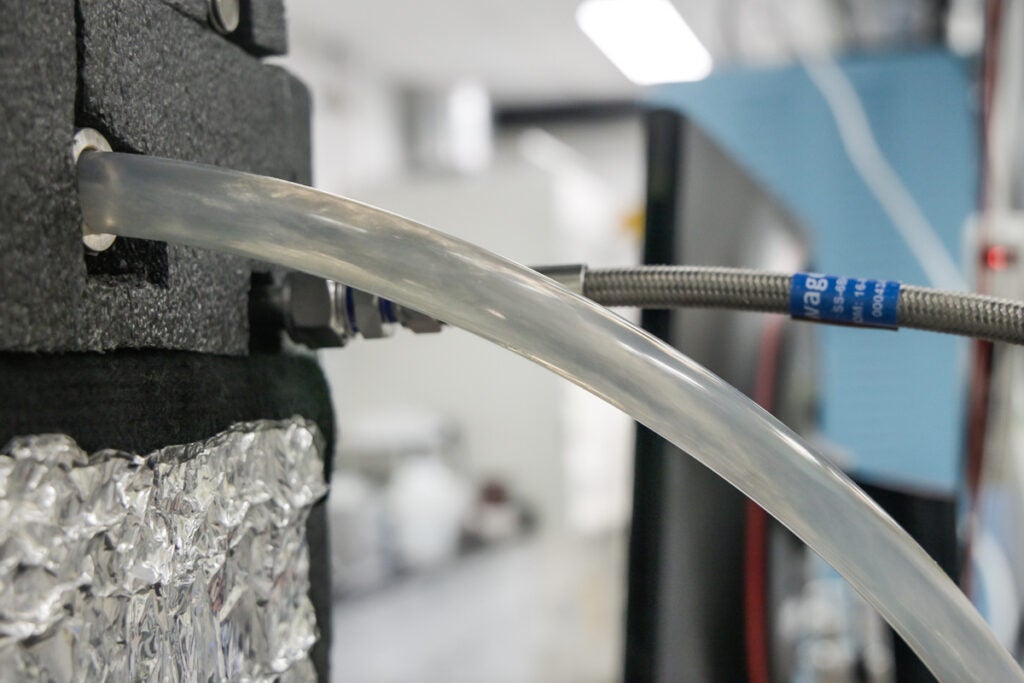
Still, Pivovar says, excess wind and solar actually need hydrogen, because it’s better to make hydrogen with it than just dumping it off the grid — something that has already begun happening in California. Hydrogen provides a way to store excess renewables, he said.
“In the end, a sustainable energy system is what I would like for the planet, and that system has to be based on renewables and hydrogen, to a large part.”
But opponents say Pennsylvania is not California. It doesn’t have the same solar capacity, and while the Biden administration has done much to spur the growth of offshore wind, it has received a lot of pushback from communities. Ørsted, a major offshore wind developer, recently pulled out of two projects off the coast of New Jersey because of inflation, rising interest rates and global supply chain issues. Meanwhile, current nuclear plants will be aging out.
“We don’t necessarily trust the energy sources that they say they are going to use, or the longevity of those sources,” said Tammy Murphy, who attended the hydrogen hub event at the union hall in Northeast Philly. “So it’s going to be fairly obvious that the resource available is fossil fuels.”
Some other hydrogen hubs, like the ARCH2 in western Pennsylvania, Ohio and West Virginia, have carbon capture and sequestration baked into its plans — something most climate activists oppose.
Many of the opponents in attendance at the union hall had direct experience with Energy Transfer’s Mariner East natural gas liquids pipeline cutting through their backyards in suburban Philadelphia, where construction caused dangerous sinkholes, fouled private water wells and damaged wetlands across the state. They are worried that another round of pipelines, whether new or re-sleeved, will be even more dangerous.
Christina DiGiulio now has a filter hooked up to her tap water because the pipeline construction damaged the aquifer she drew from. She’s also a chemist who worked in research and development for the federal government and now works for Physicians for Social Responsibility.
“This is a theory right now, and we are the experiment they are going to use to test it,” DiGiulio said. “My fear is that this is just perpetuating the fossil fuel industry and their corporate partners.”
But one person excited to talk about Philadelphia’s hydrogen economy is Jim Snell.
Snell runs the Steamfitters Local 420, where the contentious first meeting about the hydrogen hub took place. Snell said the energy transition from fossil fuels to hydrogen can’t come soon enough, especially since the closure of the PES refinery in southwest Philadelphia almost five years ago led to a loss of hundreds of building trades jobs.
“What does it mean to us and to labor in the Philadelphia region?” he asked. “To have something like this get awarded to us, a hydrogen hub, that industrial world coming back at some point — it’s jobs.”
Snell sees his apprenticeship training program tripling in size because of all the new projects to support hydrogen producers and consumers in the area. He sees more young people in the Philadelphia area moving into the middle class, and he sees the area’s industrial legacy returning.
The Department of Energy is still in negotiations with MACH2 officials. There are stringent requirements for public engagement that the D.O.E says must go beyond one-way communication of settled plans. It also comes under the Biden Administration’s Justice40 Initiative, which requires 40% of all benefits from the plan go to disadvantaged communities.
While opponents remain skeptical, MACH2 officials say more public meetings will come. And they promise opportunities for the public to contribute to the planning in a meaningful way.
If it all goes forward, it would be several years before any shovels are in the ground.

Get daily updates from WHYY News!
WHYY is your source for fact-based, in-depth journalism and information. As a nonprofit organization, we rely on financial support from readers like you. Please give today.




